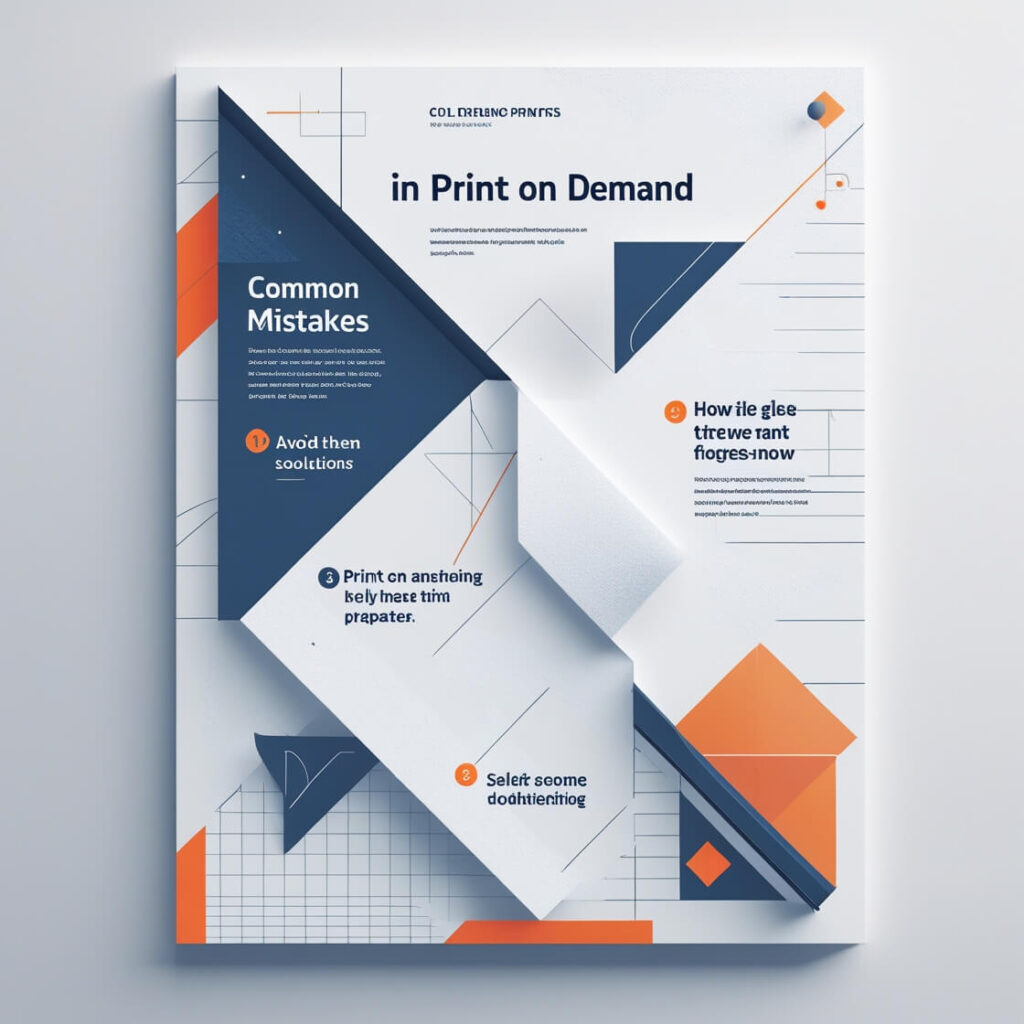Introduction:
Print on Demand (POD) has revolutionized the e-commerce world, offering entrepreneurs a low-risk way to sell custom products without holding inventory. With minimal upfront investment, it’s an appealing option for those looking to start their own online business. However, as with any business model, there are common mistakes that many POD sellers make that can severely impact their success. From poor design choices to mispricing products, these errors can be costly and difficult to recover from.
In this post, we’ll walk you through the most common mistakes in Print on Demand, offering insights on how to avoid them. Whether you’re just starting your POD business or looking to refine your existing strategy, understanding and addressing these pitfalls is key to scaling your business and ensuring long-term success.
Using Low-Quality Designs and Images
One of the most significant mistakes that new Print on Demand sellers make is using low-quality designs and images. The design of your products is the first impression your customers have of your brand, and it can make or break a sale. When customers purchase a product, they expect the design to be crisp, professional, and high-quality, whether it’s a T-shirt, mug, or phone case. If your designs appear blurry, pixelated, or poorly executed, it can turn potential buyers away and negatively impact your brand’s reputation.
Why This Is a Mistake:
Print on Demand products often require designs to be printed at high resolutions to ensure they appear clear and sharp. If the images you use aren’t high resolution, they may get distorted during the printing process, leading to poor-quality finished products that customers won’t be happy with. This can result in product returns, negative reviews, and a loss of customer trust.
The Impact of Low-Quality Designs:
- Poor Customer Experience: A blurry or pixelated design will not only make your products look unprofessional but can also be frustrating for customers who expect quality.
- Brand Damage: Inconsistent or poorly designed items can give your business a negative reputation, making it harder to build brand loyalty and trust.
- Decreased Sales: Customers are unlikely to purchase products with subpar designs, especially when they can find higher-quality alternatives from competitors.
How to Avoid This Mistake:
- Use High-Resolution Designs: Always create or purchase designs with a resolution of 300 DPI (dots per inch) to ensure sharp, clean printing. This is especially important for products like apparel, where designs cover large areas.
- Invest in Professional Design Tools: While platforms like Canva are great for beginners, using professional tools like Adobe Illustrator or Photoshop can give you greater control over your designs. These tools allow you to create vector images that can be scaled without losing quality.
- Hire a Professional Designer: If you’re not confident in your design skills, consider hiring a professional graphic designer. Many freelance platforms like Fiverr or Upwork offer affordable design services that can elevate your brand’s visuals.
- Test Your Designs: Before launching your designs for sale, test them by uploading them to a POD service (like Printful or Teespring) to see how they look on a product. This can help you spot any issues with resolution, scaling, or colors before they go live.
Conclusion:
To thrive in the competitive world of Print on Demand, it’s crucial to prioritize the quality of your designs. The effort you put into ensuring your designs are crisp, clear, and professional will pay off in the form of happier customers, stronger brand identity, and ultimately, increased sales. Avoiding low-quality designs and images is a simple but impactful step toward building a successful POD business.
This expanded section provides more in-depth insights on why using low-quality designs is a common mistake in the POD business and offers practical tips on how to avoid it, along with the impact it can have on your business. It’s meant to help readers understand the critical role of high-quality visuals in the POD industry and how to improve their designs to avoid costly errors.
How to Avoid These Print on Demand Mistakes
Now that we’ve explored some of the most common mistakes in the Print on Demand business, let’s dive into how you can avoid these pitfalls and set yourself up for long-term success. By taking proactive steps in key areas like design quality, market research, customer feedback, and pricing strategies, you can avoid the costly mistakes that many new POD sellers make. Below are actionable tips to help you improve your POD business.
H3: 1. Invest in High-Quality Designs and Products
The importance of high-quality designs cannot be overstated. The design is the centerpiece of your POD product, and it can make the difference between a sale and a missed opportunity. Here’s how to make sure your designs are up to the task:
Steps to Avoid Low-Quality Designs:
- Use High-Resolution Files: Always use images that are 300 DPI (dots per inch) or higher. This ensures that your designs are crisp and clear when printed on products. Many POD platforms provide templates that you can download to help with the correct dimensions.
- Avoid Overused Clipart: While clipart can be a great starting point, overused or generic images can make your designs look unoriginal. Instead, focus on creating custom artwork that resonates with your target audience.
- Consider Professional Design Tools: If you’re serious about your POD business, consider investing in professional design tools like Adobe Illustrator or Photoshop. These programs give you much more control over the design process compared to free tools like Canva, especially when it comes to scaling and creating high-quality, print-ready artwork.
- Test Your Designs Before Launching: Many POD platforms offer mockups of products with your designs. Take advantage of this feature to see how your design looks on different items like T-shirts, mugs, and posters. This can help you spot issues with the design’s placement, scaling, or color that may not be immediately obvious.
By investing time and resources into creating high-quality, professional designs, you’ll not only improve the customer experience but also strengthen your brand’s identity in a competitive market.
H3: 2. Conduct Thorough Market Research
A major mistake that many new POD sellers make is jumping into the market without doing sufficient research. Without understanding what products are trending, what your competitors are offering, or who your target customers are, it’s easy to miss the mark and waste valuable resources. Here’s how to ensure your market research is effective:
Steps to Conduct Effective Market Research:
- Identify Your Niche: The key to POD success is to find a profitable niche that aligns with your passions or interests while also having a market demand. Whether it’s custom T-shirts for pet owners or mugs for coffee enthusiasts, defining your niche will help you tailor your designs and marketing efforts to the right audience.
- Use Market Research Tools: Tools like Google Trends, Etsy’s search bar, and social media platforms can help you spot current trends and identify what products are in demand. Pay attention to the types of POD products that are trending, as well as the designs that are getting the most attention.
- Competitor Analysis: Keep an eye on other POD sellers in your niche. Look at what they are offering, their pricing strategies, and the type of content they share. This can help you understand what works, what doesn’t, and what opportunities exist for differentiation.
- Engage with Your Target Audience: Use social media or platforms like Reddit and Facebook groups to interact with your potential customers. Ask for feedback on your designs, get a sense of their preferences, and understand their buying behavior. Engaging with your audience can provide invaluable insights that will help you refine your products and marketing strategies.
By doing thorough market research, you’ll avoid launching products that aren’t aligned with customer demand, which can save you both time and money while maximizing your chances of success.
H3: 3. Use Customer Feedback for Continuous Improvement
Customer feedback is one of the most valuable resources you can tap into as a POD seller. Ignoring feedback or failing to act on it is a mistake that can hurt your sales and reputation. Here’s how to effectively use customer feedback to improve your products and business practices:
Steps to Leverage Customer Feedback:
- Encourage Reviews: Make it easy for customers to leave reviews by sending follow-up emails after a purchase. Positive reviews build credibility, while negative reviews offer an opportunity for improvement. Encourage feedback both on the product and the customer experience to get a well-rounded understanding of areas that need work.
- Address Negative Reviews Promptly: If a customer leaves a negative review, don’t ignore it. Respond professionally, apologize if necessary, and offer solutions or refunds when appropriate. Showing that you care about your customers’ concerns will build trust and demonstrate that you are committed to improving your business.
- Analyze Patterns in Feedback: Look for common themes in your reviews. If multiple customers mention a particular issue, such as poor sizing or faded print quality, it’s a red flag that needs to be addressed. Constantly reviewing and acting on feedback helps you improve your products and services over time.
- Use Social Media for Direct Interaction: Social media is another platform where you can receive real-time feedback from your customers. Engage with your followers, ask for suggestions, and incorporate their feedback into future designs or product offerings. Building a loyal community will not only give you insights into what your customers want but will also create brand advocates who spread positive word-of-mouth.
Actively listening to and acting on customer feedback is an essential part of growing your POD business. By showing that you care about your customers’ opinions, you foster loyalty and increase the likelihood of repeat sales.
H3: 4. Perfect Your Pricing Strategy
Pricing is one of the most critical aspects of your POD business. Mispricing your products—whether overpricing or underpricing—can severely impact your sales and profits. Here’s how to develop a smart pricing strategy that aligns with your goals:
Steps to Set the Right Price for Your POD Products:
- Know Your Costs: Always calculate the full cost of producing and shipping your products, including platform fees, design costs, and marketing expenses. Make sure your pricing covers these costs and allows for a reasonable profit margin. Tools like POD platform calculators can help you estimate the final cost per item.
- Research Competitor Pricing: Take a look at how competitors in your niche are pricing similar products. While you don’t want to copy their prices, understanding the pricing landscape can give you a benchmark to work from. Be sure to factor in the quality of your designs, product uniqueness, and brand positioning when setting prices.
- Factor in Profit Margins: Your pricing strategy should include a markup that ensures a sustainable profit margin. For example, if your total cost to produce a T-shirt is $10, you may want to price it at $25 to ensure that after platform fees, shipping, and other costs, you still make a healthy profit.
- Offer Discounts and Promotions Wisely: While running sales and promotions can attract customers, avoid relying too heavily on discounts as a primary selling point. Offering too many sales can devalue your products and hurt your brand’s perception. Instead, focus on creating a solid product lineup and use discounts strategically to boost sales during peak times like holidays or product launches.
By perfecting your pricing strategy, you’ll ensure that your POD business is both competitive in the marketplace and profitable in the long run.
Conclusion
By following these actionable steps—investing in high-quality designs, conducting thorough market research, leveraging customer feedback, and perfecting your pricing strategy—you’ll be well on your way to avoiding the most common Print on Demand mistakes. Consistently applying these best practices will help you build a strong foundation for your POD business and achieve sustained growth. Remember, avoiding mistakes and learning from them is a key part of success in the world of Print on Demand. Stay proactive, and your business will thrive!
Conclusion
Starting and growing a successful Print on Demand (POD) business is an exciting journey, but like any entrepreneurial venture, it comes with its share of challenges. By understanding the most common mistakes that new POD sellers often make, you’re already one step ahead in avoiding them. Mistakes like using low-quality designs, neglecting market research, ignoring customer feedback, and mispricing products can hinder your business’s growth and lead to lost sales and damaged reputation.
However, as we’ve discussed, these issues are entirely preventable. By prioritizing high-quality designs, conducting thorough market research, listening to your customers, and developing a smart pricing strategy, you can set your POD business up for long-term success. The key is to remain proactive, adapt to the evolving market, and continually improve your processes.
Remember, every successful POD seller has faced challenges along the way, but it’s how they respond and learn from those challenges that sets them apart. Whether you’re just starting out or looking to refine your current POD strategy, applying these best practices will help you avoid common pitfalls and keep your business on track.
Don’t be afraid to experiment, take feedback seriously, and always look for opportunities to grow. By following the steps outlined in this post, you’ll build a strong foundation, create loyal customers, and increase your chances of sustained success in the competitive world of Print on Demand.
If you’re ready to take your POD business to the next level, now’s the time to act. Start implementing these strategies today, and watch your business flourish.
This conclusion wraps up the main takeaways from your post and motivates your readers to take actionable steps to avoid mistakes and grow their POD business effectively. It also encourages them to continuously learn and improve their approach, which is essential for long-term success.



